The first attempt at an amphibian was the Orukter Amphibolos, built in 1805 by Oliver Evans, then living in Philadelphia. It was a steam carriage only by courtesy, even though Evans, an amazingly prolific inventor, had filed America's first 'motor car' patent in 1792.
Orukter Amphibolos
As early as 1775 he had obtained a monopoly over steam carriages and mills in the state of Maryland, proposing '
A steam engine ... an entire new plan ... propelling and carriages to travel with heavie burdens up and down hills, without the aid of animal fource'. However, he did nothing until an outbreak of yellow fever in the early 1800s gave him a sharp reminder of man's mortality.
To clear his conscience, he immediately began work on a steam carriage. Basically, it was a flat-bottomed barge to be used for dredging Philadelphia's harbour on the River Schuykill, but to get it to the water, Evans equipped Orukter Amphibolos with axles and wheels, driving one wheel by belt and pulleys from the flywheel shaft of the machine's twin-cylinder grasshopper beam engine.
Orukter scaled, it is reported, around 20 tons, so it is hardly surprising that the first set of wheels and axle-trees collapsed under its weight. Evans's loyal workmen 'voluntarily offered to make, without wages, other wheels and axle trees' and, incidentally, enabled Evans to put on the world's first motor show, in July 1805, when Orukter Amphibolos was exhibited in Central Square, Philadelphia, for twenty-five cents a look.
The Amphibious Tricycle
Sadly, when the machine splashed into the Schuykill, and its stern paddlewheel took over, it was the end of any attempts to produce an amphibious vehicle for around seventy years. The next amphibian to appear was only pedal-powered, even though for sheer lunacy it would be hard to beat. The Amphibious Tricycle was the brainchild of a Mr Terry. When taken apart, re-assembled and covered with stretched canvas, it became a 12 ft boat. Mr Terry rowed his convertible cockle-shell across the English Channel in the summer of 1883, 'showing the courage, determination and endurance of an Englishman'.
Beach and Harris Cycle Raft
His machine was as impracticable as the Beach and Harris 'Cycle Raft' of 1894, which featured twin inflatable pontoons to keep an ordinary safety cycle afloat. 'Neatness and Simplicity' trumpeted the company's advertising, but the Cycle Raft was manifestly neither neat nor simple and the idea sank without trace.
Ravailler's Amphibian
Came the motor age and a Parisian named Ravailler developed a canoe-shaped car, which made its maiden voyage on 8 June 1907. Powered by a 20 hp engine, Ravailler's amphibian was driven by a propeller when in the water, the solid-tyred disc wheels acting as rudders. Ravailler later took his machine to America, where it was exhibited under the name 'Water-Land 1'; he seems to have continued his experiments, as in 1915 photos appeared in the British press of an amphibian which bore all the hallmarks of a Ravailler design. The Badminton Magazine described this new vehicle as 'A new type of motor which can be used as a boat or as a road vehicle; the propeller is removed when the car is being used on the roads ... the machine is surely more of a freak than a serious attempt at motor development'.
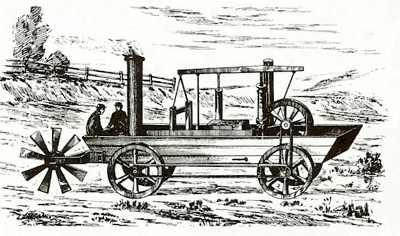
Probably the very first amphibious craft, the Orukter Amphibolos built in 1805 by Oliver Evans of Philidelphia.
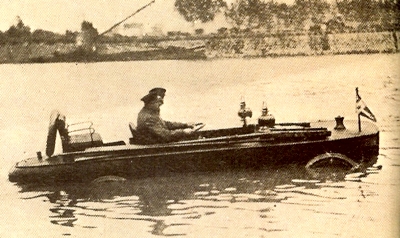
1907 Ravallier "Water-Land 1", powered by a 20hp engine. The solid disc wheels acted as rudders when afloat.
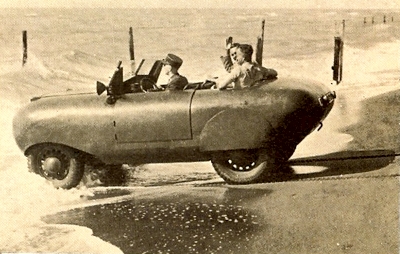
1938 Demonstration of a Hans Trippel Amphibious design.
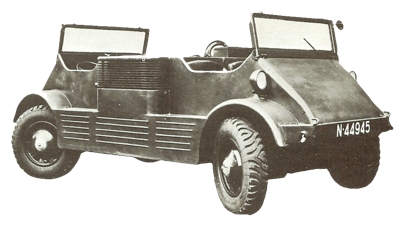
In 1938 Daf produced this vehicle. It had its engine centrally located and could be steered at either end, enabling it to travel in either direction with equal ease.
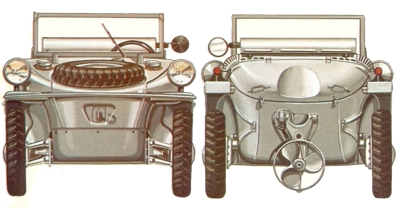 The most sophisticated of World War 2 personnel carriers was the Porsche 128, or Schwimmwagen, designed by Dr Ferdinand Porsche and used by the Wehrmacht throughout the war. It featured an ingenious hinged propellor driven by a take-off dog at the rear of the vehicle. Its speed in water was about 6 mph, and on land it could reach up to 50 mph. By the time production ceased in 1944, a total of 14,265 had been built. The most sophisticated of World War 2 personnel carriers was the Porsche 128, or Schwimmwagen, designed by Dr Ferdinand Porsche and used by the Wehrmacht throughout the war. It featured an ingenious hinged propellor driven by a take-off dog at the rear of the vehicle. Its speed in water was about 6 mph, and on land it could reach up to 50 mph. By the time production ceased in 1944, a total of 14,265 had been built.
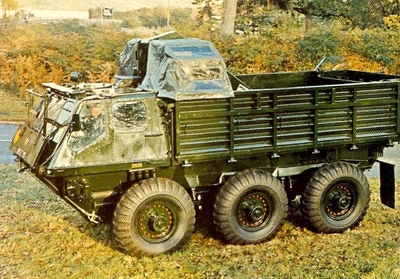
The Alvis Stalwart was
powered by a 6.5 litre
Rolls-Royce engine.
Twin Dowty pumps jetted
water out behind the
vehicle, driving it through
the water. Steering was by
means of the four front
wheels.
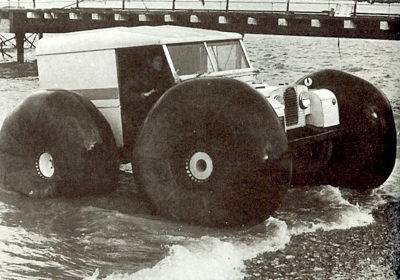
Another method
used to keep vehicles
afloat is to fit huge
'flotation' tyres.
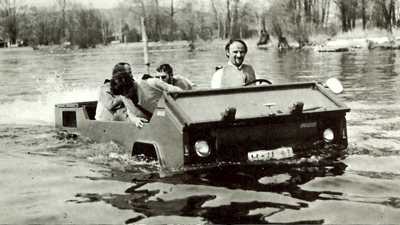
The MBB featured
a 2-litre BMW engine and
a five-speed gearbox,
giving it a road speed
of around 65 mph
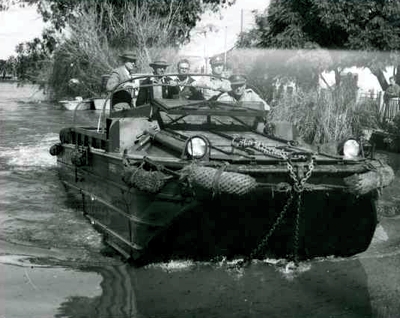
The US Army Duck.
|
The Floating 27-ton Mk IX Tank
The military authorities would hardly have agreed with this view, as they were experimenting with an amphibious version of their latest weapon, the tank. Trials were made in 1916 with a Mk IV tank, and culminated towards the end of the war with a floating version of the 27-ton Mk IX, suspended between two steel floats. In America, the
front wheel drive pioneer Waiter Christie was also developing an amphibious tank fitted with a 75 mm cannon.
Once the pressures of the war had eased, amphibious vehicle projects once again took on their old, somewhat ludicrous, air. In 1926 students of Wisconsin University attempted to make a floating car out of a Model T Ford. It sank. Also in America, a couple of years later, there were reports of a curious streamlined amphibian driven by a rear-mounted, 70 hp aero-engine with a pusher airscrew. Speeds of 80 mph on land and 25 mph on water were claimed.
The SG6 Amphibious Adler
In 1932, the imperious figure of Hans Trippel entered the field of amphibious cars. So successful was his
prototype that production began in 1934 at Homburg, in the Saar, with the SG6, featuring four- wheel-drive and a four-cylinder Adler engine, plus a propeller for use in the water. This model was later powered by a six-cylinder 2. 5-litre Opel engine. Ostensibly, Trippel's amphibians were for use on large estates and forestry work, plus the conveyance of well-heeled sportsmen on hunting, shooting and fishing trips, but Hans was a good German and had not ignored the military potential of his invention.
Trippel the Obersturmbannfuhrer Takes Over Bugatti
A new version appeared in 1937, with
front wheel drive and a 2-Iitre Adler engine. Then came World War 2 and demand for the amphibians increased. Trippel, now an Obersturmbannfuhrer and a member of Hitler's advisory staff, took over the Bugatti factory at Molsheim, Alsace, commandeered the machine tools that Ettore Bugatti had sent to Bordeaux in an attempt to escape the German invasion of France, and began production of twenty amphibians a month.
Porsche's Strength Through Joy - Porsche 128/Schwimmwagen
The military Trippels had the 2.5-litre Opel engine and could reach 50 mph on land. Around 1000 were produced in all. Some had a rear-mounted Tatra V8, 3-litre engine and four-wheel-drive, introduced in 1943, while an armoured variant appeared in 1944. However, it was not the Trippel that provided the bulk of the Wehrmacht's amphibians, but a lighter vehicle based on the Volkswagen 'Strength through joy' private car designed by Dr Ferdinand Porsche and sponsored by the Nazi Party. Indeed, the first 150 Schwimmwagens produced for field trials in 1940 were known as the Porsche 128.
In 1942 Volkswagen put an improved version of this four-wheel-drive amphibian into production. The Schwimmwagen featured an ingenious hinged 'out- board' water propeller which, when in use, was driven by a power take-off dog at the rear of the body. Speed in water was 6 miles per hour and on the road 50 mph, the familiar
air-cooled VW 1-litre, flat-four being the power unit. By the time production ended in 1944, a total of 14,265 Schwimmwagens had left Wolfsburg.
Even More Wehrmacht Amphibians
There were still more amphibious vehicles on the Wehrmacht's strength: in 1935 Rheinmetall-Borsig of Dusseldorf began experiments with a Land-Wasser-Schlepper, an amphibious towing vehicle, which eventually went into production around 1940. Typical of the L-W-S types produced was the Sachsenberg, a massive, twin-screw machine with crawler tracks and a V12, 30 bhp Maybach engine. A crew of twenty was carried, and the machine scaled thirteen tons.
The Allies also had plenty of amphibious tricks up their sleeves, especially in the United States. Here development of amphibious cargo and personnel transporters got under way in 1941, as a joint project between Marmon-Herrington and New York boat-builders Sparkrnan & Stevens, based on the Jeep chassis. This 'Seep' went into production at Ford in September 1942, but under half of the more than 12,000 orders for this machine were fulfilled. Sparkman & Stevens also developed a larger six- wheel-driven machine, the DUKW, popularly known as the 'Duck'.
The Duck, The Zil and The Water Weasel
Based on a GMC truck chassis, the Duck was the most successful amphibian of the war, with a total production to mid 1945 of over 21,000 - and many remained in use for decades after the war. An unusual feature of the Duck was the built-in ability to vary the
tyre pressures while on the move to suit the terrain it was crossing.
After the war the Russians produced a modified Duck, the ZIL-485, with extra cargo space and a tailgate. More unorthodox was the Studebaker M29 Water Weasel. In general layout it followed the 1937 'Alligator' designed by Donald Roebling. This was an amphibious half-track which could cope with the swamps and pools of the Florida Everglades.
The LVT (Landing Vehicle Tracked)
The Water Weasel was a cargo carrier with a ro cwt load capacity, powered by a six-cylinder engine. In the water it was propelled by its tracks, at a speed of around 4 mph. Around 15,000 were produced. Larger vehicles with the same overall layout were built under the general designation LVT - Landing Vehicle Tracked - with model names like Water Buffalo and Alligator, produced in both open and turret-top versions. Most of the LVTs were powered by Continental seven-cylinder radial engines, although the Mk III version used two Cadiliac V8 engines. The Mk III and later Mk IV LVTs could carry a payload of 6000 lb. A total of 18,620 LVTs were produced for the American and British armed forces.
The Terrapin and Neptune
Britain attempted to produce an equivalent to the LVT so that they should not be entirely dependent on American supplies of military amphibians, but their designs generally failed to come up to requirements. Most successful was the Terrapin, built by Thorny-Croft and Morris Commercial - and only 500 of the Mk I version were produced.
An all-wheel-drive, eight-wheeler, the Terrapin was powered by two Ford V8 engines. The full-track Neptune designed by Morris, was the nearest equivalent to the LVT, with a payload of four to five tons, but the massive Morris-Commercial Argosy never got past the
prototype stage. Although this full-track amphibian was powered by a V 12 Liberty engine and could carry a nine-ton payload in a rough sea, it was too heavy and was very difficult.
At the other end of the size scale came the tiller-steered Morris Gosling, an amphibious trolley designed by (Sir) Alex Issigonis and powered by a 2 bhp Villiers engine. It was only good for use in calm water. Britain's main contribution to the design of military amphibians was the development of the swimming tank. This was the brainchild of the Polish engineer Nicolas Stranssler, who operated a design company in London. First fitted to a Tetrarch light tank in 1941, the Straussler DD flotation equipment consisted of a flexible waterproof skirt with an inflatable rim which could be raised around the superstructure of the tank to turn it in to an amphibian, with propeller drive.
The Straussler gear was so successful that soon it was being fitted to eighteen-ton Valentine tanks, then to thirty-ton Sherman tanks. 102 of these were used in the D-Day landings, swimming ashore from two miles out at sea. The Americans used flotation gear, too, though their SD - Swimming Device - was no more than a couple of inflatable airbags either side of the vehicles. Amphibians were used by other fighting powers too - Russia had an amphibious armoured car based on the GAZ (Ford) chassis, while the Japanese used limited numbers of a Duck-like machine built by Toyota as well as the SR amphibious navy tank.
The Alvis Stalwart
After the war, military development of amphibians continued - one of the more interesting designs was the Alvis Stalwart, which drove on all six wheels and steered with the front four. Also built by Berliet in France under the name Aurochs, the Stalwart had a 6.5-litre Rolls-Royce engine and was chiefly remarkable for its mode of propulsion on water - twin Dowty pumps jetted out water behind the vehicle to thrust it along. Waterjet propulsion of a similar type had been featured on a light amphibian designed by the French engineer Petit in 1950, the 850 cc, twin-cylinder Dyna Panhard engine being rear-mounted.
The civil amphibian did not really establish itself on the market until 1959, when Hans Trippel, after an unsuccessful attempt at building a conventional land car, exhibited a new light amphibian at Geneva. Originally known as the Eurocar, with an Austin A35 engine, by the time Trippel's new design reached production in 1961 it had become known as the
Amphicar, with an 1147 cc Triumph Herald engine. Twin propellers took over the propulsion in the water, giving a speed of around 6
½ knots, while the undriven front wheels acted as rudders. The seaworthiness of the Amphicar's welded steel hull was proved in 1962, when one of the vehicles crossed the English Channel.
The Unorthodox Channel Crossing
A more unorthodox Channel crossing came in 1963 when a Ford tractor 'drove' from England to France, buoyed up by the air in its oversize tyres. 'Flotation tyres' have been used to convert other 'sinkable' vehicles such as Land-Rovers into amphibians, too. They were also a feature of a small, plastic, all-terrain vehicle shown by Crayford Conversions at the 1971 Earls Court Motor Show.
Plastics were a feature of an East German amphibian, the MBB (Messerschmitt, Bolkow and Blohm), driven by a rear-mounted BMW 2-litre engine with a five-speed gearbox, giving 65 mph on land, allied to an ability to climb a sixty degree slope. Despite its modern construction, the MBB was not greatly advanced in basic concept, compared with Trippel's early designs.
The Chrysler LVW
Far more ingenious was the Chrysler LVW driven by a gas turbine, with wheels which retracted into the body while the vehicle was travelling on water. Vehicles of this type were built for military use without particular regard for cost. Private amphibians, on the other hand, had to be fairly simple in design to enable production and retail costs to be kept down. And demand was always very limited - nearly all the private amphibians were Trippel designed - and even today the amphibian vehicle is never likely to be much more than an ingenious curiosity.




